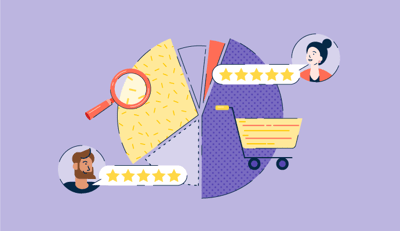January 26, 2023
 by Washija Kazim / January 26, 2023
by Washija Kazim / January 26, 2023

Sales is no longer about selling.
The practice has evolved from focusing on simply closing leads to opening new and long-term relationships. Nowadays, businesses need to be more strategic and focus on building trust before pitching to prospects.
Every business – no matter what it is or where it is – wants to increase sales. Some try tweaking their marketing strategies, enforcing sales performance management software, and perfecting their website. Others rely on sales analytics tools to forecast numbers and insights, only to get mixed results.
But what if it didn’t have to be a trial-and-error approach? What if you could implement effective sales strategies that focus on the fundamentals and give straightforward solutions? If that sounds better than crossing your fingers and wishing, keep reading.
Besides earning greater profits, an increase in sales builds customer loyalty, spreads brand awareness, and brings repeat business. Plus, new buyers will feel more confident about purchasing from a business with a good number of sales and a satisfied customer base.
It's important to focus on ways that bring in more profitable sales revenue. But how do you truly increase sales? Try these 13 timeless strategies to increase sales effectively for your business.
A sales strategy acts as a roadmap for securing reliable, long-term revenue through retaining existing customers and attracting leads. Your sales strategy must focus on their needs and highlight distinct goals, budgets, and time frames for your campaigns.
When creating a sales strategy to increase sales, keep the five Ps in mind:
Businesses should also know how to trigger customer needs with targeted strategies using specific keywords that improve search engine optimization (SEO). Once you have a robust strategy in place, you can begin experimenting with other tactics to make more money.
Marketing efforts are vital to building interest in your business. Unless there’s interest in your product, you can't tap into an audience willing to pay for it. Whether you have a small online storefront or chains across the country, we’ve got some practical ways for you to increase sales through digital marketing techniques.
Businesses also love to display the love they get from happy customers through testimonials and case studies on their websites, which acts as another great form of marketing. A blend of all these techniques goes a long way in promoting your business to your target audience.
Before getting down to a sales pitch, put together a list of your prospects. Then, find the right contacts.
A lot of newbies repeat the same mistake. They write to the only company email they can find on the internet. As a result, their sales pitches end up in spam and trash folders. The recipient needs to know who you are trying to reach out to, whether it’s a product manager, an HR representative, or the company's CEO.
A personalized and well-written professional email is far more likely to get a response than sending your proposal to mass email addresses like info@email.com. So how does anybody find the right contact?
First, define the job title of the person responsible for implementing or purchasing what you're offering. Second, search for their work email address. Email-finding extensions will help you discover the correct email through the company's website.
Once you've found the right person to contact, don't limit yourself to emails only. LinkedIn Sales Navigator has proved to be an excellent tool for business negotiations. You can also use buyer intent data providers (ahem – like G2!) to identify exactly why prospects are interacting with your brand and use that data to market to them.
Lastly, try contacting lower-level employees. It’s a known fact that salespeople are far more responsive than upper management.
The elevator pitch tactics work for online communication as well. The only difference is that in the case of emails, three minutes in the elevator turns into three seconds of reading the email's subject line.
You may possess the mental dexterity to compose a killer sales pitch, but writing skills aren't enough to get a response from your recipient. These seven simple rules will help you boost both the email open rates and response rates:
And last but not least: follow-ups are great until they turn into spam.
It all starts with understanding your customers. If you want to get more customers to finalize their purchase, it's essential to know a buyer journey, which includes:
Customer relationship management (CRM) software is the go-to for entrepreneurs who need to track and optimize their selling process. When you start a business, choosing the right CRM is crucial. Even if you're a fan of standard spreadsheets, you’ll be surprised at what a game-changer CRM can be.
CRMs help sellers to:
Salesforce Sales Cloud
HubSpot Sales Hub
ActiveCampaign
Zoho
monday sales CRM
*These are the five leading CRM software from G2’s Winter 2023 Grid® Report.
And if you need more time to consider paying for additional services, you can explore free CRMs. For example, NetHunt stays free for two-people sales teams.
Your customers don’t want to know that you work in the best company or sell an outstanding product that changes lives. They want to know how your product can add value to their life and work. Showing your value proposition means that, along with highlighting the abstract uniqueness of your product, emphasize a couple of concrete solutions that your product offers.
Suppose you’re selling marketing automation software. In this case, you can accentuate how your software helps
It’s also a great approach to explore what your recipients are doing in a company before reaching out to them. In fact, read more about the company itself. This information lets you customize your sales proposal, making it more specific to their needs. Show what your product can do for your potential customers right there and then.
Even if you’re sure that your emails can sell anything to anyone, there’s a strong chance that you can do better. So if you didn’t receive any responses after your last mailout, it might be time to rewrite your sales email template.
For instance, people might not be signing up for your free trial due to unclear messaging. This is why test-driving different email templates and checking stats is a good practice. Which email had the highest open rate? How many website visits did you get after a mass mailing? CRMs and email tracking software will help you monitor and control all these essential metrics.
You should also be aware of spam filters. To achieve higher credibility, equip your email with a proper signature that contains your photo, job title, the company’s logo, and links to your LinkedIn profile, Skype, or other messengers you may use for work.
The email should also have a proper sender’s name and never be sent from addresses like noname@product.com.
Businesses use audience builders to collect data and categorize people based on several factors. Then, the companies target their well-designed marketing campaigns to the most interested groups. Previous actions, customer preferences, and demographics are some elements to consider when forming a group.
Tools like audience builders help businesses get to know their customers and provide insight into their actions. With this gathered data, you can create impressive lists of audiences and increase sales by building a personalized experience for your clients.
Source: PayKickstart.com
For instance, you could build a list that shows which users decided not to make a purchase and abandoned their carts after visiting the site. That data can be used to re-target these customers with a campaign carefully designed to re-engage them and encourage them to return to your checkout page to complete their purchase.
of sales professionals obtain high-quality leads from existing customer referrals.
Source: HubSpot
As great as the affiliates are for marketing your campaigns, products, or services, you have to be careful. Third-party seller tools can easily hack and infiltrate your revenue stream. A good tactic is to use affiliate marketing software to manage everything in one place. In that way, affiliates don't have to wait 30-60 days for their payment. The very second conversion is made, your affiliate gets the reward.
So how does this increase sales? Just think about who is likely to work harder – the affiliate getting instant rewards or the one waiting two months to get paid.
A well-planned upselling strategy significantly lowers the cost of online marketing and increases the likelihood of customers purchasing from you. Upselling helps you make the most of each sale. You look at what fulfills the customer's needs and build on loyalty. The seller and the buyer both get value from these kinds of purchases.
Of course, making the experience seamless is critical. For instance, offer a checkout experience without the need to enter payment details again. You can also create a personalized upsell based on the product or customer purchase history.
Even if your upsell is irresistible, making the purchase experience easy is equally crucial. Many shopping carts witness massive drop-off rates of abandonment due to complicated payment gateways and checkout processes.
A great example of an upselling strategy is Amazon. The website always suggests more items to add to your cart based on your previous purchases, browsing history, or current cart items. And if the customer decides to buy an item, all it takes is a single click, making it instant and easy.
Customizing checkout pages that appeal to your customers considerably impacts your online sales. If you present a buyer with the exact purchase list and the segmented total, including discounts, you encourage them to gauge their interest in your other products without much effort on your part.
Suppose you’re looking for more potential customers to finalize their purchase. You need to increase at least one of these three factors: motivation, ability, or trigger. A customized checkout process increases the motivation to move down the conversion funnel by making the purchase quicker.
Every checkout page has to showcase information clearly; it should have the items added to the cart and upsells that correlate to the main offer or products previously added to the cart. A great touch is adding product photos of items added to the cart.
of US online shoppers have abandoned orders due to a complicated checkout process.
Source: Baymard Institute
You can make the process simple for customers by customizing your checkout page and setting it up to pre-fill all the required fields for them. That way, you immediately remove the barrier, allowing them to continue their purchase seamlessly.
You should also include a Buy Now button that connects with the checkout page. With a one-click upsell option enabled, your customers can purchase more products. Other options, such as the Keep Shopping or Continue to Checkout buttons, are a nice touch to the whole buying experience.
When you’ve put enough effort into attracting customers to your business, how do you keep them engaged and interested? A customer loyalty program!
It costs a lot less to sell to existing customers than to acquire new ones, which is why brands choose to invest in loyalty and rewards programs. Loyalty programs are a great way to keep your ideal customer engaged and reward their commitment to your brand with discounts, free products, and insider perks.
Your customer segment is far more likely to spend on your product when they receive incentives for their purchases. It also generates word-of-mouth referrals, social media shares, and repetitive purchases.
Business owners and retailers share the dream of witnessing a sharp increase in sales when they tweak their strategies. It won’t happen overnight, you need to start somewhere.
Along with introducing new products and expanding your market, engage with new customers to build lasting relationships. And regardless of your industry, market, or business goals, implementing the right mix of these strategic methods will improve your sales process – one step at a time.
Now that you know how to improve your sales strategy and maximize revenue, check out the top-rated sales enablement software on G2 to augment your selling potential.
Washija Kazim is a Sr. Content Marketing Specialist at G2 focused on creating actionable SaaS content for IT management and infrastructure needs. With a professional degree in business administration, she specializes in subjects like business logic, impact analysis, data lifecycle management, and cryptocurrency. In her spare time, she can be found buried nose-deep in a book, lost in her favorite cinematic world, or planning her next trip to the mountains.
Cooking a gourmet meal and buying software have a lot in common. Both are more complex than...
 by Chris Perrine
by Chris Perrine
"Buyers reign supreme." This would be the shortest summary of what we found out about B2B...
 by Soundarya Jayaraman
by Soundarya Jayaraman
Wrangling tough clients. Chasing quota under pressure. Learning the ins and outs of your...
 by Mary Clare Novak
by Mary Clare Novak
Cooking a gourmet meal and buying software have a lot in common. Both are more complex than...
 by Chris Perrine
by Chris Perrine
"Buyers reign supreme." This would be the shortest summary of what we found out about B2B...
 by Soundarya Jayaraman
by Soundarya Jayaraman


